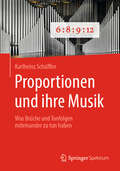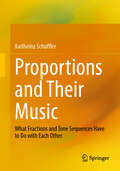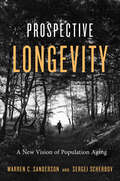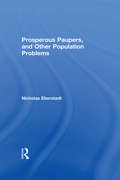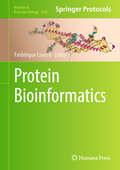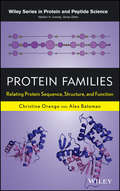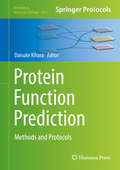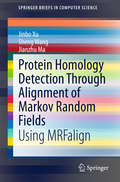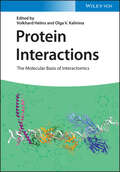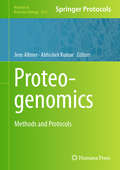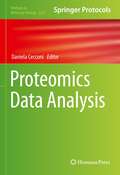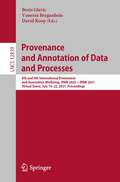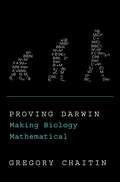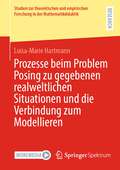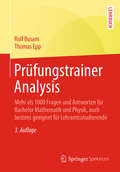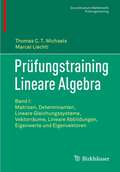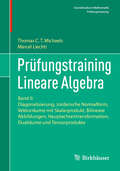- Table View
- List View
Proportionen und ihre Musik: Was Brüche und Tonfolgen miteinander zu tun haben
by Karlheinz SchüfflerKlänge können harmonisch sein, Zahlenfolgen auch – ein Zufall? Dieses Buch behandelt eine musikalische Proportionenlehre, also die antike Lehre der Proportionen als die älteste und wichtigste gemeinsame Verankerung der beiden Kulturwissenschaften Mathematik und Musik. Die Musiktheorie der Töne, Intervalle, Tetrachorde, Klänge und Skalen ist nämlich das genaue musikalische Abbild der Gesetze der Arithmetik und ihrer Symmetrien in dem Regelwerk des Spiels mit Zahlen, ihren Proportionen und ihren Medietäten. Alleine schon das Wunder der sogenannten Harmonia perfecta maxima 6 – 8 – 9 – 12, deren Proportionen die Quinte sowie die Quarte bestimmen, die Oktave bilden und den ehernen Ganzton in ihrer Mitte haben, prägte das musikalische Gebäude der pythagoräischen Musik über Jahrtausende. Diese elementare Proportionenkette 6 : 8 : 9 : 12 ist zudem vollkommen symmetrisch und aus der arithmetischen wie auch aus der harmonischen Medietät der Oktavzahlen 6 und 12 aufgebaut. Dieses Buch entwickelt die Proportionenlehre als eine mathematische Wissenschaft und stellt ihr immer die musikalische Motivierung mittels zahlreicher Beispiele gegenüber. Die Leitidee ist die Herleitung einer Symmetrietheorie von der Harmonia perfecta maxima bis hin zur Harmonia perfecta infinita abstracta, einem Prozess unbeschränkter Tongenerierungen durch babylonische Mittelwerte-Iterationen. Dabei wird hieraus simultan sowohl die klassisch-antike Diatonik gewonnen als auch der Weg „vom Monochord zur Orgel“ neu beleuchtet. Das Werk enthält schließlich eine von der Mathematik geleitete Hinführung zu der antiken Tetrachordik wie auch zu den kirchentonalen Skalen und schließt mit einem Exkurs in die Klangwelten der Orgel. Hierbei führt uns die „Fußzahlregel der Orgel“ anhand von Beispielen in die Welt der klanglichen Dispositionen dieses Instruments und zeigt die Allgegenwärtigkeit der antiken Proportionenlehre auf. Dieses Buch eignet sich für alle, die Interesse an Mathematik und Musik haben.
Proportions and Their Music: What Fractions and Tone Sequences Have to Do with Each Other
by Karlheinz SchüfflerSounds can be harmonic, number sequences too - a coincidence?This book deals with a musical theory of proportions, i.e. the ancient doctrine of proportions as the oldest and most important common anchorage of the two cultural sciences mathematics and music.The musical theory of tones, intervals, tetrachords, sounds and scales is in fact the exact musical image of the laws of arithmetic and its symmetries in the set of rules of playing with numbers, their proportions and their medievals. Alone the miracle of the so-called Harmonia perfecta maxima 6 - 8 - 9 - 12, whose proportions determine the fifth as well as the fourth, form the octave and have the brazen whole tone in their center, shaped the musical edifice of Pythagorean music for thousands of years. This elementary chain of proportions 6 : 8 : 9 : 12 is, moreover, completely symmetrical and built up from the arithmetic as well as from the harmonic medieta of the octave numbers 6 and 12.This book develops the theory of proportions as a mathematical science and always contrasts it with the musical motivation by means of numerous examples. The main idea is the derivation of a theory of symmetry from the Harmonia perfecta maxima to the Harmonia perfecta infinita abstracta, a process of unlimited tone generations by Babylonian mean iterations. From this, both the classical-antique diatonic is simultaneously extracted and the path "from the monochord to the organ" is re-examined.Finally, the work contains a mathematically guided introduction to the ancient tetrachordics as well as to the church tonal scales and concludes with an excursion into the sound worlds of the organ. Here the "foot-number rule of the organ" leads us by means of examples into the world of the tonal dispositions of this instrument and shows the omnipresence of the ancient theory of proportions. This book is suitable for anyone with an interest in mathematics and music.This book is a translation of the original German 1st edition Proportionen und ihre Musik by Karlheinz Schüffler, Springer-Verlag GmbH Germany, part of Springer Nature in 2019. The translation was done with the help of artificial intelligence (machine translation by the service DeepL.com). A subsequent human revision was done primarily in terms of content, so that the book will read stylistically differently from a conventional translation. Springer Nature works continuously to further the development of tools for the production of books and on the related technologies to support the authors.
Prospect Theory
by Peter P. WakkerProspect Theory: For Risk and Ambiguity provides the first comprehensive and accessible textbook treatment of the way decisions are made both when we have the statistical probabilities associated with uncertain future events (risk) and when we lack them (ambiguity). The book presents models, primarily prospect theory, that are both tractable and psychologically realistic. A method of presentation is chosen that makes the empirical meaning of each theoretical model completely transparent. Prospect theory has many applications in a wide variety of disciplines. The material in the book has been carefully organized to allow readers to select pathways through the book relevant to their own interests. With numerous exercises and worked examples, the book is ideally suited to the needs of students taking courses in decision theory in economics, mathematics, finance, psychology, management science, health, computer science, Bayesian statistics, and engineering.
Prospective Longevity: A New Vision of Population Aging
by Warren C. Sanderson Sergei ScherbovWarren Sanderson and Sergei Scherbov argue for a new way to measure individual and population aging. Instead of counting how many years we’ve lived, we should think about our “prospective age”—the number of years we expect to have left. Their pioneering model can generate better demographic estimates, which inform better policy choices.
Prosperous Paupers and Other Population Problems
by Nicholas EberstadtIn current intellectual and public discourse, the entire modern world-from the affluent United States to the poorest low-income regions-is beset today by a broad and alarming array of "population problems." Around the globe, leading scientists, academics, and political figures attribute poverty, hunger, social tension, and even political conflict t
Protecting Privacy through Homomorphic Encryption
by Kristin Lauter Wei Dai Kim LaineThis book summarizes recent inventions, provides guidelines and recommendations, and demonstrates many practical applications of homomorphic encryption. This collection of papers represents the combined wisdom of the community of leading experts on Homomorphic Encryption. In the past 3 years, a global community consisting of researchers in academia, industry, and government, has been working closely to standardize homomorphic encryption. This is the first publication of whitepapers created by these experts that comprehensively describes the scientific inventions, presents a concrete security analysis, and broadly discusses applicable use scenarios and markets. This book also features a collection of privacy-preserving machine learning applications powered by homomorphic encryption designed by groups of top graduate students worldwide at the Private AI Bootcamp hosted by Microsoft Research.The volume aims to connect non-expert readers with this important new cryptographic technology in an accessible and actionable way. Readers who have heard good things about homomorphic encryption but are not familiar with the details will find this book full of inspiration. Readers who have preconceived biases based on out-of-date knowledge will see the recent progress made by industrial and academic pioneers on optimizing and standardizing this technology. A clear picture of how homomorphic encryption works, how to use it to solve real-world problems, and how to efficiently strengthen privacy protection, will naturally become clear.
Protecting Your Privacy in a Data-Driven World (ASA-CRC Series on Statistical Reasoning in Science and Society)
by Claire McKay BowenAt what point does the sacrifice to our personal information outweigh the public good? If public policymakers had access to our personal and confidential data, they could make more evidence-based, data-informed decisions that could accelerate economic recovery and improve COVID-19 vaccine distribution. However, access to personal data comes at a steep privacy cost for contributors, especially underrepresented groups. Protecting Your Privacy in a Data-Driven World is a practical, nontechnical guide that explains the importance of balancing these competing needs and calls for careful consideration of how data are collected and disseminated by our government and the private sector. Not addressing these concerns can harm the same communities policymakers are trying to protect through data privacy and confidentiality legislation.
Protein Bioinformatics (Methods in Molecular Biology #2836)
by Frédérique LisacekThis detailed volume explores techniques for protein bioinformatics research, including databases, software tools, and computational methods, in the context of protein science or proteomics and opening to other omics areas. Beginning with a section on proteogenomics, the book continues by covering posttranslational modifications, processing large-scale mass spectrometry data, protein structure and interactions, as well as protein feature inference. Written for the highly successful Methods in Molecular Biology series, chapters include the kind of detailed implementation advice to ensure efficacious results. Authoritative and practical, Protein Bioinformatics serves as an ideal guide for researchers in disciplines encompassing the biotechnological, pharmaceutical, biological, and medical sciences, as well as the computational and engineering sciences.
Protein Bioinformatics: From Protein Modifications and Networks to Proteomics (Methods in Molecular Biology #1558)
by Cathy H. Wu Cecilia N. Arighi Karen E. RossThis volume introduces bioinformatics research methods for proteins, with special focus on protein post-translational modifications (PTMs) and networks. This book is organized into four parts and covers the basic framework and major resources for analysis of protein sequence, structure, and function; approaches and resources for analysis of protein PTMs, protein-protein interactions (PPIs) and protein networks, including tools for PPI prediction and approaches for the construction of PPI and PTM networks; and bioinformatics approaches in proteomics, including computational methods for mass spectrometry-based proteomics and integrative analysis for alternative splice isoforms, for functional discovery. Written in the highly successful Methods in Molecular Biology series format, chapters include introductions to their respective topics, lists of the necessary materials and reagents, step-by-step, readily reproducible laboratory or computational protocols, and tips on troubleshooting and avoiding known pitfalls.Cutting-edge and thorough, Protein Bioinformatics: From Protein Modifications and Networks to Proteomics is a valuable resource for readers who wish to learn about state-of-the-art bioinformatics databases and tools, novel computational methods, and future trends in protein and proteomic data analysis in systems biology. This book is useful to researchers who work in the biotechnology and pharmaceutical industries, and in various academic departments, such as biological and medical sciences and computer sciences and engineering.
Protein Families
by Alex Bateman Vladimir Uversky Christine OrengoNew insights into the evolution and nature of proteinsExploring several distinct approaches, this book describes the methods for comparing protein sequences and protein structures in order to identify homologous relationships and classify proteins and protein domains into evolutionary families. Readers will discover the common features as well as the key philosophical differences underlying the major protein classification systems, including Pfam, Panther, SCOP, and CATH. Moreover, they'll discover how these systems can be used to understand the evolution of protein families as well as understand and predict the degree to which structural and functional information are shared between relatives in a protein family.Edited and authored by leading international experts, Protein Families offers new insights into protein families that are important to medical research as well as protein families that help us understand biological systems and key biological processes such as cell signaling and the immune response. The book is divided into three sections: Section I: Concepts Underlying Protein Family Classification reviews the major strategies for identifying homologous proteins and classifying them into families. Section II: In-Depth Reviews of Protein Families focuses on some fascinating super protein families for which we have substantial amounts of sequence, structural and functional data, making it possible to trace the emergence of functionally diverse relatives. Section III: Review of Protein Families in Important Biological Systems examines protein families associated with a particular biological theme, such as the cytoskeleton.All chapters are extensively illustrated, including depictions of evolutionary relationships. References at the end of each chapter guide readers to original research papers and reviews in the field.Covering protein family classification systems alongside detailed descriptions of select protein families, this book offers biochemists, molecular biologists, protein scientists, structural biologists, and bioinformaticians new insight into the evolution and nature of proteins.
Protein Function Prediction
by Daisuke KiharaGene function annotation has been a central question in molecular biology. The importance of computational function prediction is increasing because more and more large scale biological data, including genome sequences, protein structures, protein-protein interaction data, microarray expression data, and mass spectrometry data, are awaiting biological interpretation. Traditionally when a genome is sequenced, function annotation of genes is done by homology search methods, such as BLAST or FASTA. However, since these methods are developed before the genomics era, conventional use of them is not necessarily most suitable for analyzing a large scale data. Therefore we observe emerging development of computational gene function prediction methods, which are targeted to analyze large scale data, and also those which use such omics data as additional source of function prediction. In this book, we overview this emerging exciting field. The authors have been selected from 1) those who develop novel purely computational methods 2) those who develop function prediction methods which use omics data 3) those who maintain and update data base of function annotation of particular model organisms (E. coli), which are frequently referred
Protein Homology Detection Through Alignment of Markov Random Fields
by Jinbo Xu Sheng Wang Jianzhu MaThis work covers sequence-based protein homology detection, a fundamental and challenging bioinformatics problem with a variety of real-world applications. The text first surveys a few popular homology detection methods, such as Position-Specific Scoring Matrix (PSSM) and Hidden Markov Model (HMM) based methods, and then describes a novel Markov Random Fields (MRF) based method developed by the authors. MRF-based methods are much more sensitive than HMM- and PSSM-based methods for remote homolog detection and fold recognition, as MRFs can model long-range residue-residue interaction. The text also describes the installation, usage and result interpretation of programs implementing the MRF-based method.
Protein Interactions: The Molecular Basis of Interactomics
by Volkhard HelmsProtein Interactions A fundamental guide to the burgeoning field of protein interactions From enzymes to transcription factors to cell membrane receptors, proteins are at the heart of biological cell function. Virtually all cellular processes are governed by their interactions, with one another, with cell bodies, with DNA, or with small molecules. The systematic study of these interactions is called Interactomics, and research within this new field promises to shape the future of molecular cell biology. Protein Interactions goes beyond any existing guide to protein interactions, presenting the first truly comprehensive overview of the field. Edited by two leading scholars in the field of protein bioinformatics, this book covers all known categories of protein interaction, stable as well as transient, as well as the effect of mutations and post-translational modifications on the interaction behavior. Protein Interactions readers will also find: Introductory chapters on protein structure, conformational dynamics, and protein-protein binding interfaces A data-driven approach incorporating machine learning and integrating experimental data into computational models An outlook on the current challenges in the field and suggestions for future research Protein Interactions will serve as a fundamental resource for novice researchers who want a systematic introduction to interactomics, as well as for experienced cell biologists and bioinformaticians who want to gain an edge in this exciting new field.
Proteogenomics: Methods and Protocols (Methods in Molecular Biology #2859)
by Jens Allmer Abhishek KumarThis volume presents an up-to-date overview of the current state-of-the-art protocols, and aims to put proteogenomics into a broader perspective. The chapters in this book detail methods and techniques ranging from mass spectrometry to proteomics and proteogenomics and their biomedical implications and applications. Written in the highly successful Methods in Molecular Biology series format, the chapters include introductions to their respective topics, application details for both the expert and non-expert reader, and tips on troubleshooting and avoiding known pitfalls. A highlight for everyone new to the field are the chapters, which put proteogenomics to use to answer biomedical questions. Authoritative and accessible, Proteogenomics: Methods and Protocols aims to ensure successful results in the further study of this vital field.
Proteomics Data Analysis (Methods in Molecular Biology #2361)
by Daniela CecconiThis thorough book collects methods and strategies to analyze proteomics data. It is intended to describe how data obtained by gel-based or gel-free proteomics approaches can be inspected, organized, and interpreted to extrapolate biological information. Organized into four sections, the volume explores strategies to analyze proteomics data obtained by gel-based approaches, different data analysis approaches for gel-free proteomics experiments, bioinformatic tools for the interpretation of proteomics data to obtain biological significant information, as well as methods to integrate proteomics data with other omics datasets including genomics, transcriptomics, metabolomics, and other types of data. Written for the highly successful Methods in Molecular Biology series, chapters include the kind of detailed implementation advice that will ensure high quality results in the lab. Authoritative and practical, Proteomics Data Analysis serves as an ideal guide to introduce researchers, both experienced and novice, to new tools and approaches for data analysis to encourage the further study of proteomics.
Prototyping Python Dashboards for Scientists and Engineers: Build and Deploy a Complete Dashboard with Python
by Padraig HoulahanCreate interactive and data-driven dashboards using Python. This hands-on guide is a practical resource for those (with modest programming skills) in scientific and engineering fields looking to leverage Python's power for data visualization and analysis in a user-friendly dashboard format. You’ll begin by gaining a fundamental understanding of Python programming, including data types, lists, dictionaries, and data structures. The book then delves into the world of reactive programming with Plotly and Dash, offering a hands-on approach to building interactive web-based dashboards. Next, you’ll see how to work with online data, how to scrape and clean datasets, and keep files up-to-date. The book also guides you through planning a dashboard prototype, outlining project tasks, trends, forecasts, spectra, and other design considerations. It concludes with a discussion of how the dashboard can be used for data visualization of real data, explaining the usefulness of tools such as spectra. By providing detailed examples for download and customization, Prototyping Python Dashboards for Scientists and Engineers will equip you with the skills needed to jumpstart your own development efforts. What You’ll Learn Design a dashboard with PythonConvert and filter Excel formatted files to produce CSV filesCreate browser-served graphics with PLOTLYGenerate polynomial trend lines for forecastingBuild a Unix service to share your dashboard Who This Book Is For Scientists, engineers, students, programmers, and data enthusiasts who aspire to harness Python's potential for data visualization and analysis through the creation of interactive dashboards. Many will be pragmatic programmers with modest skills and limited resources who mainly want to see a working solution they could emulate.
Provenance and Annotation of Data and Processes: 8th and 9th International Provenance and Annotation Workshop, IPAW 2020 + IPAW 2021, Virtual Event, July 19–22, 2021, Proceedings (Lecture Notes in Computer Science #12839)
by Boris Glavic Vanessa Braganholo David KoopThis book constitutes the proceedings of the 8th and 9th International Provenance and Annotation Workshop, IPAW 2020 and IPAW 2021 which were held as part of ProvenanceWeek in 2020 and 2021. Due to the COVID-19 pandemic, PropvenanceWeek 2020 was held as a 1-day virtual event with brief teaser talks on June 22, 2020. In 2021, the conference was held virtually during July 19-22, 2021. The 11 full papers and 12 posters and system demonstrations included in these proceedings were carefully reviewed and selected from a total of 31 submissions. They were organized in the following topical sections: provenance capture and representation; security; provenance types, inference, queries and summarization; reliability and trustworthiness; joint IPAW/TaPP poster and demonstration session.
Proving Darwin: Making Biology Mathematical
by Gregory ChaitinGroundbreaking mathematician Gregory Chaitin gives us the first book to posit that we can prove how Darwin's theory of evolution works on a mathematical level. For years it has been received wisdom among most scientists that, just as Darwin claimed, all of the Earth's life-forms evolved by blind chance. But does Darwin's theory function on a purely mathematical level? Has there been enough time for evolution to produce the remarkable biological diversity we see around us? It's a question no one has yet answered--in fact, no one has even attempted to answer it until now. In this illuminating and provocative book, Gregory Chaitin argues that we can't be sure evolution makes sense without a mathematical theory. He elucidates the mathematical scheme he's developed that can explain life itself, and examines the works of mathematical pioneers John von Neumann and Alan Turing through the lens of biology. Chaitin presents an accessible introduction to metabiology, a new way of thinking about biological science that highlights the mathematical structures underpinning the biological world. Fascinating and thought-provoking, Proving Darwin makes clear how biology may have found its greatest ally in mathematics.
Prozesse bei der strukturierenden Mengenwahrnehmung und strukturnutzenden Anzahlbestimmung von Kindern im Elementarbereich: Eine Eye-Tracking Studie
by Priska SprengerPriska Sprenger untersucht Prozesse bei der strukturierenden Mengenwahrnehmung und strukturnutzenden Anzahlbestimmung von Kindern im Elementarbereich. Sie führt dazu eine Interventionsstudie im Pre-, Post-, Follow-up-Design mit 95 Kindern durch und entwickelt ein Auswertungsverfahren auf Basis einer Datentriangulation. Analysiert wird, welchen Mehrwert Eye-Tracking bieten kann, um Einblicke in den nicht sichtbaren Prozess der Mengenwahrnehmung zu gewinnen sowie welche Strukturen Kinder wahrnehmen und wie sie diese zur Anzahlbestimmung nutzen. Außerdem wird untersucht, ob eine Strukturwahrnehmung und -nutzung auf eine spielerische Art und Weise gefördert werden kann. Die Ergebnisse der Studie bieten Anknüpfungspunkte für die Gestaltung der frühen mathematischen Bildung und für weitere Forschung, sowohl im vorschulischen als auch im schulischen Bereich.
Prozesse beim Problem Posing zu gegebenen realweltlichen Situationen und die Verbindung zum Modellieren (Studien zur theoretischen und empirischen Forschung in der Mathematikdidaktik)
by Luisa-Marie HartmannIn einer qualitativ-explorativen Studie untersucht Luisa-Marie Hartmann die Prozesse beim Problem Posing zu gegebenen realweltlichen Situationen und die Verbindung zum mathematischen Modellieren. Dazu wurden die Entwicklungs- und Bearbeitungsphasen angehender Lehrkräfte mit Hilfe einer inhaltlich-strukturierenden qualitativen Inhaltsanalyse tiefgehend analysiert. Sowohl bei der Entwicklung als auch bei der Bearbeitung der eigenen Aufgaben konnten Problem Posing- und Modellierungsaktivitäten identifiziert werden. Basierend auf den identifizierten Aktivitäten und deren Verbindungen entwickelt die Autorin Hypothesen, die zur Erweiterung des Modellierungskreislaufs aus einer Problem Posing-Perspektive genutzt werden.
Präzises Denken für Informatiker
by Karsten WolfDas Lehrbuch befasst sich mit dem präzisen Denken, einer Schlüsselkompetenz im Studium der Informatik. Es bildet die Vorstufe für das Verständnis der logischen Grundfunktionen der Informatik. Das Erlernen der mathematischen Logik ist ein wesentlicher Bestandteil des Grundstudiums, da das logische Denken in der Informatik auf den gleichen Regeln und Techniken basiert wie in der Mathematik. Der Autor führt umfassend in die Aussagenlogik ein und erklärt unter anderem die Bedeutungen von logischer Äquivalenz, Implikation und Induktion für diesen Fachbereich. Darüber hinaus definiert er den Beweis aus Sicht der Mathematik und stellt grundlegende Beweisstrategien vor, die im Studium benötigt werden. Mit den in diesem Lehrbuch vorgestellten Techniken des präzisen Denkens erwerben die Studenten die Fähigkeit, Begriffe punktgenau zu definieren, Aussagen trennscharf zu formulieren und ihre Richtigkeit angemessen zu begründen. Viele praxisnahe Aufgaben und Lösungshinweise innerhalb der Kapitel erleichtern die Überprüfung und Vertiefung des Lernstoffs. Der Autor richtet sich vornehmlich an Bachelorstudenten der ersten Semester. Sie finden in diesem Werk eine optimale Vorbereitung auf die Logik-Seminare ihres Informatikstudiums. Die vermittelten Kompetenzen verbessern dabei nicht nur das Verständnis im Informatik-Studium, sondern sind ebenso für das spätere Berufsleben von großer Bedeutung. Darüber hinaus erhalten auch interessierte Laien mit diesem Buch einen interessanten Einblick in die Welt der Informatik und Mathematik und lernen, dass die Fähigkeit zu präzisem Denken auch jenseits dieser Fachbereiche hilfreich sein kann.
Prüfungstrainer Analysis
by Rolf Busam Thomas EppDieser „Prüfungstrainer“ wendet sich an Studierende mit Mathematik als Haupt- oder Nebenfach, die – insbesondere bei der Prüfungs- oder Klausurvorbereitung – den Wunsch verspüren, als Ergänzung zu den Lehrbüchern den umfangreichen Stoff des Analysisgrundstudiums noch einmal in pointierter Form vorliegen zu haben, zugespitzt auf dasjenige, was man wirklich wissen und beherrschen sollte, um eine Prüfung erfolgreich zu bestehen und exakte Antworten auf mögliche Fragen formulieren zu können.In einem konzisen Frage-Antworten-Stil werden die zentralen Begriffe und Beweise der Analysis wiederholt. Mehr noch als auf die Rechenfähigkeit (die sicherlich auch notwendig ist und nicht zu kurz kommt) wird dabei Wert auf das grundsätzliche Verständnis wichtiger Konzepte gelegt. Dem Autorenduo – einem Dozenten mit langjähriger Vorlesungs- und Prüfungserfahrung und einem Mathematikabsolventen – ist es sehr gut gelungen, mit der Auswahl der Fragen ein realistisches Bild davon zu vermitteln, was einen Studenten in der mündlichen Prüfung oder einer Klausur typischerweise erwartet.Durch die Gliederung des Stoffes in einzelne Fragen eignet sich das Buch ausgezeichnet dazu, Wissen stichpunktartig zu trainieren und zu überprüfen; auch höhere Semester können davon profitieren, wenn sie schon einmal Gelerntes noch einmal gezielt nachschlagen wollen. Eine besondere Attraktion stellen die ca. 180 Abbildungen dar, die geometrische Sachverhalte veranschaulichen.Die 2. Auflage wurde vollständig durchgesehen, didaktisch weiter verbessert und um neue Fragen ergänzt.
Prüfungstraining Lineare Algebra: Band I: Matrizen, Determinanten, Lineare Gleichungssysteme, Vektorräume, Lineare Abbildungen, Eigenwerte und Eigenvektoren (Grundstudium Mathematik)
by Marcel Liechti Thomas C.T. MichaelsDieses Trainingsbuch ist das ideale Begleitbuch für alle Bachelorstudierenden im Fach Mathematik und für die Grundlagenvorlesungen in ingenieur-, natur- und wirtschaftswissenschaftlichen Studiengängen. Es ist speziell geeignet zur Vorbereitung auf Assessmentprüfungen und Basisprüfungen im Themenbereich Lineare Algebra. In Band I werden die folgenden zentralen Themen behandelt: Matrizen, DeterminantenLineare GleichungssystemeVektorräumeLineare AbbildungenEigenwerte und Eigenvektoren Der Stoff wird nicht in der klassischen Lehrbuch-Struktur von Definition, Satz und Beweis präsentiert, sondern kann anhand von mehr als 600 Aufgaben mit unterschiedlichen Schwierigkeitsgraden erlernt und trainiert werden. Alle Übungen werden Schritt für Schritt durchgerechnet, der Lösungsweg wird verständlich erklärt und es werden viele Rechentipps gezeigt. Dabei wird ein breites Spektrum von typischen (Prüfungs-)Aufgabentypen berücksichtigt. Am Ende geben 150 Multiple-Choice Testfragen und 4 konkrete Musterprüfungen, mit ausführlichen Lösungen, dem Leser die Möglichkeit sein Wissen final zu testen und dadurch den Stoff zu festigen.
Prüfungstraining Lineare Algebra: Band II: Diagonalisierung, Jordansche Normalform, Vektorräume mit Skalarprodukt, Bilineare Abbildungen, Hauptachsentransformation, Dualräume und Tensorprodukte (Grundstudium Mathematik)
by Marcel Liechti Thomas MichaelsMit über 600 Aufgaben mit ausführlichem Lösungsweg sowie 150 Multiple-Choice-Testfragen und 4 Musterprüfungen. Dieses Trainingsbuch ist das ideale Begleitbuch für alle Bachelorstudierenden im Fach Mathematik und für die Grundlagenvorlesungen in ingenieur-, natur- und wirtschaftswissenschaftlichen Studiengängen. Es ist speziell geeignet zur Vorbereitung auf Assessmentprüfungen und Basisprüfungen im Themenbereich Lineare Algebra. In Band II werden die folgenden zentralen Themen behandelt: Diagonalisierung und Trigonalisierung Jordansche Normalform Vektorräume mit Skalarprodukt Bilineare Abbildungen und Hauptachsentransformation Dualräume und Tensorprodukte Der Stoff wird nicht in der klassischen Lehrbuch-Struktur von Definition, Satz und Beweis präsentiert, sondern kann anhand von mehr als 600 Aufgaben mit unterschiedlichen Schwierigkeitsgraden erlernt und trainiert werden. Alle Übungen werden Schritt für Schritt durchgerechnet, der Lösungsweg wird verständlich erklärt und es werden viele Rechentipps gezeigt. Dabei wird ein breites Spektrum von typischen (Prüfungs-) Aufgabentypen berücksichtigt. Am Ende geben 150 Multiple-Choice Testfragen und 4 konkrete Musterprüfungen, mit ausführlichen Lösungen, dem Leser die Möglichkeit sein Wissen final zu testen und dadurch den Stoff zu festigen.
Prüfungsvorbereitung zum Staatsexamen Theoretische Physik: Gymnasium Bayern Jahrgänge 2017-2022
by Daniel JaudDieses Lehrbuch beinhaltet die Examensaufgaben und Lösungsvorschläge zur theoretischen Physik für das Lehramt an Gymnasien in Bayern. Da das Rechnen von Aufgaben eine zentrale Prüfungsvorbereitung darstellt, stehen in diesem Buch ausgearbeitete Lösungen zur Verfügung, um einen maximalen Lernerfolg zu erzeugen. Zusätzlich liefert das Buch zu Beginn ein kurzes Repetitorium zu allen vier großen Themenbereichen, welche im Staatsexamen geprüft werden: die klassische Mechanik, die Elektrodynamik, die Thermodynamik und statistische Physik sowie die Quantenmechanik. Das Repetitorium zu den einzelnen Themenbereichen ist dabei so gestaltet, dass nur die absolut prüfungsrelevanten Kenntnisse nochmals aufgefrischt, wiederholt und an wichtigen exemplarischen Beispielen illustriert werden. Damit liefert dieser erste Teil des Buches eine kompakte Wissenszusammenfassung aller wesentlichen theoretischen Konzepte, welche im Staatsexamen beherrscht werden sollten. Der zweite Teil des Buches mit über 96 Prüfungsangaben und ausgearbeiteten Lösungen stellt eine der umfangreichsten Sammlungen zum Staatsexamen in der theoretischen Physik dar. Dadurch, dass sich die Lösungen gleich im Anschluss zur entsprechenden Aufgabe befinden, wird es Leserinnen und Lesern ermöglicht, schnell eigene Ergebnisse beim Durcharbeiten der Aufgaben zu überprüfen und wichtige Erkenntnisse zu erlangen.
